Lumley Raw Water Pumping Station (2018)
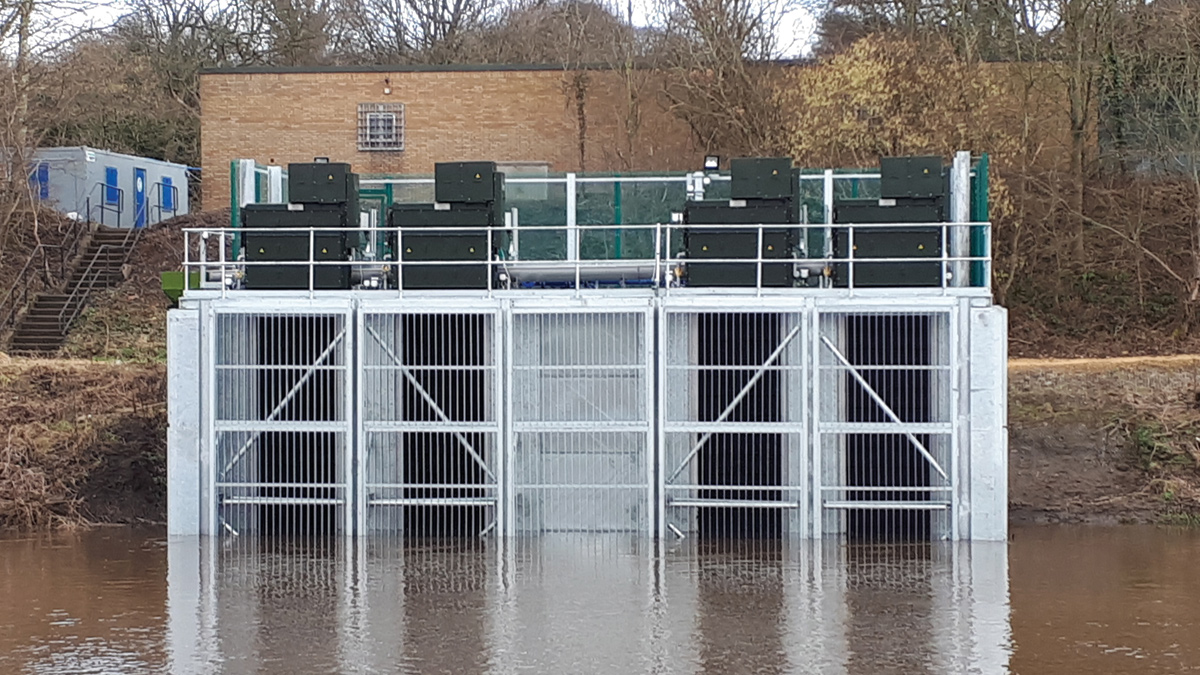
Completed structure view from the River Wear - Courtesy of Mott MacDonald Bentley
The installation of new eel and fish friendly screens at Northumbrian Water Group’s (NWG) Lumley Raw Water Pumping Station (RWPS) was the culmination of collaborative working between multiple stakeholders, to transform the screening methodology in an environmentally sensitive location. The final solution provides an option that presents immediate environmental benefits to aquatic life, with low on-going power consumption, and significantly reduced operator requirements for years to come. The project is part of a batch of four schemes, all installing purpose-built fish-exclusion, fish recovery and return screens at existing pumping stations across the Northumbrian region.
Background
Lumley Raw Water Pumping Station (RWPS) is a river intake situated on the River Wear, close to Chester-Le-Street. The RWPS is used to abstract up to 57 million litres of water from the river per day to transfer flows to Lumley WTW where the water is treated.
The Eels (England and Wales) Regulations 2009, came into force in 2015. They require, ‘owners of water undertakings and other abstractions to fit suitable screens or equivalent eel exclusion measures’, with suitability defined in the Environment Agency’s (EA) Eel Manual. The existing screening methods were non-compliant and beset with maintenance and operational issues.
NWGs notional solution identified a traditional screen used elsewhere in the region, constructed within the intake structure and requiring individual chutes to separate and return to the watercourse, entrained aquatic life and river debris. This chute for the fish and eels would have required landscaping of the downstream river bank, which is densely covered with invasive plant species.
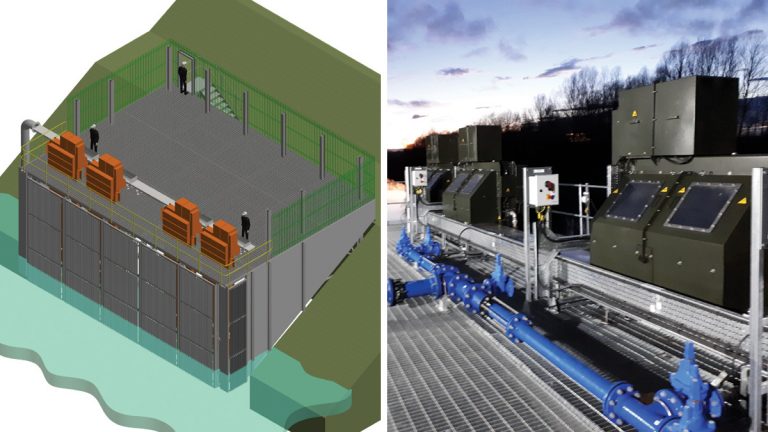
(left) 3D render of the steelwork superstructure and (right) M&E installation – Courtesy of Mott MacDonald Bentley
Undertakings
NWG awarded an investigate and define (I&D) contract to Mott MacDonald Bentley (MMB). During the I&D phase, MMB gave recommendations for new screening facilities at Lumley, Warkworth, Broken Scar and Blackwell Pumping Stations, as well as recommendations for upgrades at Pont and Wellhope Burn.
In September 2016, MMB was awarded a design and construct (D&C) contract worth c.£6m to carry out the improvements on six sites, with works programmed to continue until March 2020. The first project as part of the initial phase of works requires upgrades at Lumley RWPS.
The main project stakeholders for the scheme were Northumbrian Water Group, who own and operate the pumping station and the Environment Agency (EA), who provide screening guidelines, environmental permitting and ultimately, compliance certification. MMB consulted and worked closely with all stakeholders from an early stage to ensure that any options considered the wider benefits to all parties.
The preferred solution entailed installation of 4 (No.) environmental fish exclusion (EFE) screens within the flushing flow of the river. To accommodate this, a new steel support structure was installed on top of the existing concrete intake, constructed in 1975.
The existing intake was inspected to confirm its structural integrity and the performance of the existing substructure and new steel superstructure was modelled for 1:1000-year flood conditions.
Technical engineering excellence
The RWPS is situated in the lower reaches of the River Wear, 5km upstream of the tidal limit. The station experiences a wide range of flow conditions, with significant floods occurring on an annual basis. The importance of Lumley RWPS in NWG’s strategic network meant that the station had to remain operational throughout construction.
To ensure compliance, the screens needed to be 8m in height, and apertures in the supporting structure needed to be sealed to less than 2mm, to prevent flows from short-circuiting the screens. Both during construction and operation, the structure would be subject to forces changing in magnitude on a daily basis.
The requirement for the screens to be positioned within the flushing flow during all conditions meant that the centre of gravity was close to the front of the structure as each of the proposed EFE screens weighed 3 tonnes. Construction of a new foundation immediately in front of the intake was ruled out early due to the health and safety risks associated with use of a cofferdam and NWG’s need to continually abstract water.
The steelwork designers were challenged to develop a solution that could be cantilevered from the existing structure, enabling all fixings to be installed above the waterline. To accurately determine the effect of hydrodynamic forces, the proposed superstructure was modelled using Fastrak Building Designer and was subjected to various load combinations.
A laser scanned point cloud survey was used to create a model of the existing structure in Revit, allowing the steelwork designers to produce an accurate 3D model of the solution, well in advance of construction. The model was an excellent communication tool for D&C, securing planning permission, community liaison, fabrication, and sequencing of the works.
The river bank immediately upstream and downstream of the intake slopes steeply into the river and is densely covered with invasive plants, precluding access to construction plant. Access route constraints meant that cranes were limited to a maximum possible lift of 5 tonnes. This constraint was identified during design and the steelwork was carefully designed to be lifted in place in sections of acceptable weight, reducing the requirement for works at height over water.

Screen installation – Courtesy of Mott MacDonald Bentley
Sustainability
The project’s key driver was to improve eel stocks within the River Wear – however, the complete change in screening approach will significantly improve aquatic biodiversity within the river, particularly at higher reaches.
The previous screening regime at the pumping station used small diameter strainers creating flow velocities over 1.2m/s, entraining fish and eels of all life stages seeking refuge from the river flow in the pumps and strainers. The new exclusion system prevents fish and eels from being entrained, with velocities through the screens reduced to less than 0.25m/s even in worst-case conditions; lowest river level, maximum abstraction.
Using EFE screens ensures no requirement to capture and release entrained fish and eels, reducing trauma. The screens were chosen to meet current and anticipated regulations for other fish species, ensuring ongoing compliance in the ever-changing environmental landscape.
Cleaning of the existing strainers required regular operator input, particularly during storm conditions. The use of EFE screens ensures that the process is completely automated and the screens only operate in high silt conditions, with each screen anticipated to run for less than 90 minutes per day. The screens are driven by highly efficient motors, negating the requirement for booster pumps for washwater.
The environmental impact of construction was considered throughout design. By modifying the design to remove the need for a cofferdam within the river, there were no significant works below the waterline and the EA permitted the works to proceed without any formal silt control methods.
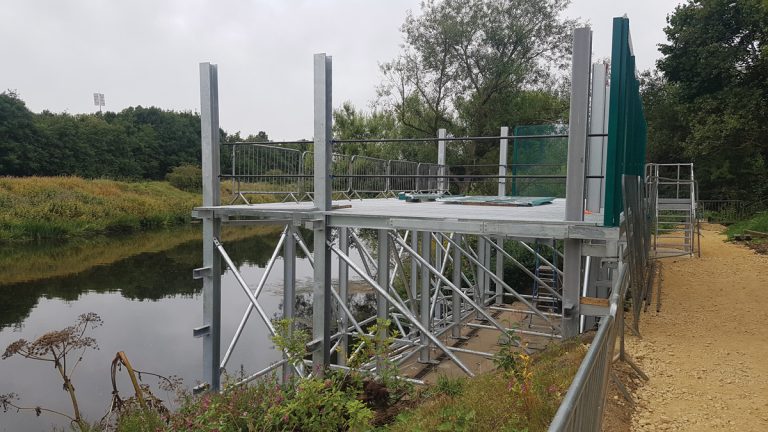
Steelwork superstructure – Courtesy of Mott MacDonald Bentley
Approach to health and safety
Collaborative planning sessions were held with NWG’s operations and maintenance team to identify current procedures and develop the design with future requirements in mind.
Working with Northumbrian Water, MMB has developed a step change in its thinking in terms of screen technology, moving away from maintenance-heavy traditional chain driven systems to multi-sprocket driven modular engineered polymer band screens. The screens feature interchangeable plastic screening panels with no moving parts below the water line. These should see reduced operational and maintenance interaction, compared to traditional chain driven systems, which are susceptible to chain failure and require almost full disassembly in order to bring back into service.
Another significant maintenance undertaking was removal of debris from the intake bays, requiring significant confined space work with single point river isolations. The design confirmed at an early stage that this requirement was unnecessary, and all maintenance could be carried out from the deck level.
Close liaison between D&C staff throughout design ensured that buildability was always considered and the move to a cantilevered structure was agreed at an early stage, as the use of a cofferdam had been identified as by far the highest risk construction activity, both in terms of safety and environmental impact.
There were no injuries of any type or environmental incidents in over 11,000 hours worked, despite the sensitivity and visibility of the site.
A strong safety culture drove these results, evidenced by over 100 proactive H&S and environmental reports during construction by operatives, subcontractors, and visitors to site. To monitor, verify and maintain these high standards, regular health, safety and environmental audits, inspections and behavioural discussions were undertaken.
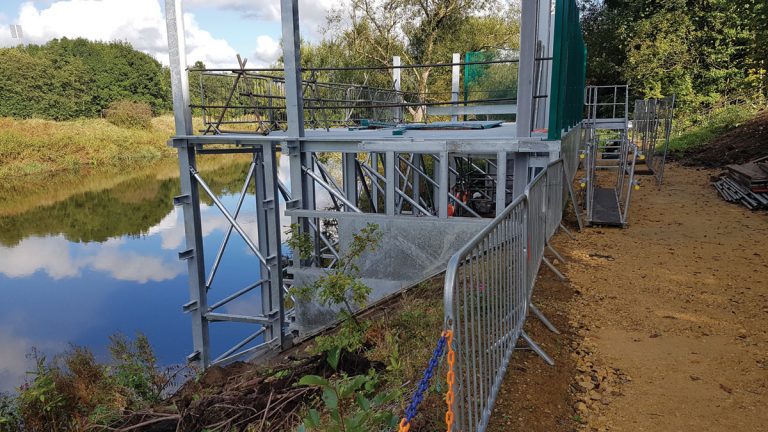
Steelwork superstructure – Courtesy of Mott MacDonald Bentley
Programme and budget
The D&C contract commenced in September 2016 with enabling works commencing in June 2017. Construction works were completed in December 2017. The site has been compliant since November 2017, significantly beating the deadline of March 2018.
Planning meetings were held between, designers, client, construction teams and key suppliers early within the delivery phase. Potential ‘blockers’ were identified and confronted within design, reducing the potential for standing time on site.
Key relationships were formed between the steelwork and screen suppliers, ensuring all four screens were comfortably installed ‘cartridge style’ without on-site modifications.
The D&C contract was delivered for £1.15m, beating the target cost estimate of £1.25m. The savings can be attributed to strong collaboration between all parties, identifying key risks and constraints and confronting them as a team.
Lumley Raw Water Pumping Station: Table of designers, contractors and suppliers
- Client: Northumbrian Water
- Principal designer: Mott MacDonald Bentley
- Main contractor: Mott MacDonald Bentley
- Steelwork design: The Shadbolt Group
- Fish exclusion screens: Hydrolox
- Structural steelwork: The Deritend Group Ltd
- Electrical installation: Intelect (UK) Ltd
- Systems integration: IDEC Technical Services Ltd
- Diving support: Northern Divers (Eng) Ltd
- MCC modifications: CEMA Ltd
Community benefit
MMB and NWG worked together to identify key local community stakeholders and commenced engagement early to determine the final design of the security features and screenings discharge arrangement.
The council, rowing, and angling clubs were engaged ensuring that both construction works, and the final solution would not impart any negative effects to river users. Rendered 3D visualisations were utilised to aid in communication and demonstrate the proposed sequence of works.
The new screens will greatly reduce the amount of fish and Eel entrained at the pumping station, and will remove a significant hazard to migratory species, particularly sea trout, eels, and salmon, with the benefits felt along the entire 100km length of the river, from source to sea. Additionally, the screens will improve resilience of the water supply to Lumley WTW.
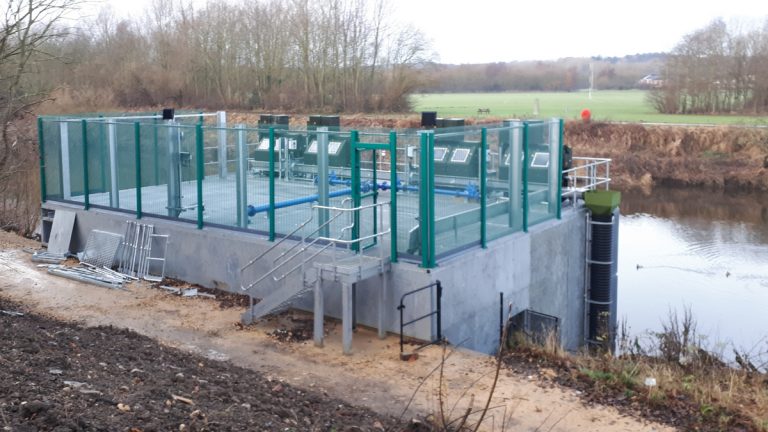
Completed structure as viewed from the bank – Courtesy of Mott MacDonald Bentley
The other 5 (No.) sites
3 (No.) new fish recovery and return (FRR) screens will be installed within the existing wet wells at Blackwell RWPS between May and August 2018. The installation and commissioning will build upon lessons learned at Lumley RWPS.
Warkworth and Broken Scar RWPS will then follow on in 2019 and 2020.
Conclusion
Each of the six Eel Regulation schemes within the wider project require significant engagement from stakeholders, particularly given the ecological impact of the permanent and temporary works at each of the sites. Strong collaboration between the Mott MacDonald Bentley and Northumbrian Water Group core team has been central to ensuring that the works have been able to continue without any disruption to supply.




